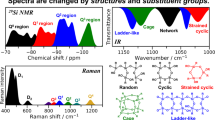Abstract
Optimal descriptors calculated with SMILES represented a structure of monomer units applied to build up a model of glass transition temperatures of diverse polymers. Quantitative structure-property relationships (QSPRs) were established for the above dataset. The statistical quality of the model of glass transition temperatures is quite good. The simplified molecular input-line entry system (SMILES) has been used to represent the molecular structure of corresponding monomers. The hybrid optimal descriptors calculated with the so-called correlation weights of molecular features extracted from SMILES and molecular hydrogen-suppressed graph (HSG) were used as the basis of the one-variable model. The index of ideality of correlation (IIC) is a new criterion of the predictive potential of the QSPR model. Here, the applicability of the IIC as a tool to improve the predictive potential of the model for glass transition temperatures is confirmed.
Similar content being viewed by others
References
Chen M, Jabeen F, Rasulev B, Ossowski M, Boudjouk P (2018) A computational structure-property relationship study of glass transition temperatures for a diverse set of polymers. J Polym Sci B Polym Phys 56:877–885. https://doi.org/10.1002/polb.24602
Toropova AP, Toropov AA, Leszczynska D, Leszczynski J (2018) The index of ideality of correlation: hierarchy of Monte Carlo models for glass transition temperatures of polymers. J Polym Res 25(10):221. https://doi.org/10.1007/s10965-018-1618-z
Veselinović JB, Đorđević V, Bogdanović M, Morić I, Veselinović AM (2018) QSAR modeling of dihydrofolate reductase inhibitors as a therapeutic target for multiresistant bacteria. Struct Chem 29:541–551. https://doi.org/10.1007/s11224-017-1051-7
Toropova AP, Toropov AA, Kudyshkin VO, Rallo R (2015) Prediction of the Q-e parameters from structures of transfer chain agents. J Polym Res 22:128. https://doi.org/10.1007/s10965-015-0778-3
Nimbhal M, Bagri K, Kumar P, Kumar A (2020) The index of ideality of correlation: a statistical yardstick for better QSAR modeling of glucokinase activators. Struct Chem 31:831–839. https://doi.org/10.1007/s11224-019-01468-w
Toropov AA, Toropova AP (2018) Improved model for biodegradability of organic compounds: the correlation contributions of rings. In: Bidoia E, Montagnolli R (eds) toxicity and biodegradation testing. Methods in pharmacology and toxicology. Humana Press, New York Chapter 8, pp 147–183
Toropova AP, Toropov AA (2017) The index of ideality of correlation: a criterion of predictability of QSAR models for skin permeability? Sci Total Environ 586:466–472. https://doi.org/10.1016/j.scitotenv.2017.01.198
Toropova AP, Toropov AA (2019) Does the index of ideality of correlation detect the better model correctly? Mol Inf 38:1800157. https://doi.org/10.1002/minf.201800157
Kumar P, Kumar A, Sindhu J (2019) Design and development of novel focal adhesion kinase (FAK) inhibitors using Monte Carlo method with index of ideality of correlation to validate QSAR. SAR QSAR Environ Res 30:63–80. https://doi.org/10.1080/1062936X.2018.1564067
Kumar P, Kumar A, Sindhu J, Lal S (2019) QSAR models for nitrogen containing monophosphonate and bisphosphonate derivatives as human farnesyl pyrophosphate synthase inhibitors based on Monte Carlo method. Drug Res 69:159–167. https://doi.org/10.1055/a-0652-5290
Duchowicz PR, Fioressi SE, Bacelo DE, Saavedra LM, Toropova AP, Toropov AA (2015) QSPR studies on refractive indices of structurally heterogeneous polymers. Chemom Intell Lab Syst 140:86–91. https://doi.org/10.1016/j.chemolab.2014.11.008
Golubović M, Lazarević M, Zlatanović D, Krtinić D, Stoičkov V, Mladenović B, Milić DJ, Sokolović D, Veselinović AM (2018) The anesthetic action of some polyhalogenated ethers-Monte Carlo method based QSAR study. Comput Biol Chem 75:32–38. https://doi.org/10.1016/j.compbiolchem.2018.04.009
Miccio LA, Schwartz GA (2020) From chemical structure to quantitative polymer properties prediction through convolutional neural networks. Polymer 193:122341. https://doi.org/10.1016/j.polymer.2020.122341
Xu J, Wang L, Zhang H, Shen X, Liang G (2012) Quantitative structure-property relationships studies on free-radical polymerization chain-transfer constants for styrene. J Appl Polym Sci 123:356–364. https://doi.org/10.1002/app.34255
Roy PP, Paul S, Mitra I, Roy K (2009) On two novel parameters for validation of predictive QSAR models. Molecules 14(5):1660–1701. https://doi.org/10.3390/molecules14051660
Acknowledgments
A.A.T. and A.P.T. express gratitude to the project LIFE-CONCERT (LIFE17 GIE/IT/000461) for the support.
Author information
Authors and Affiliations
Contributions
The authors contributed equally to this work.
Corresponding author
Ethics declarations
Conflict of interest
The authors declare that they have no conflict of interest.
Additional information
Publisher’s note
Springer Nature remains neutral with regard to jurisdictional claims in published maps and institutional affiliations.
Electronic supplementary material
ESM 1
(DOCX 19 kb)
Rights and permissions
About this article
Cite this article
Toropov, A.A., Toropova, A.P., Kudyshkin, V.O. et al. Applying the Monte Carlo technique to build up models of glass transition temperatures of diverse polymers. Struct Chem 31, 1739–1743 (2020). https://doi.org/10.1007/s11224-020-01588-8
Received:
Accepted:
Published:
Issue Date:
DOI: https://doi.org/10.1007/s11224-020-01588-8




